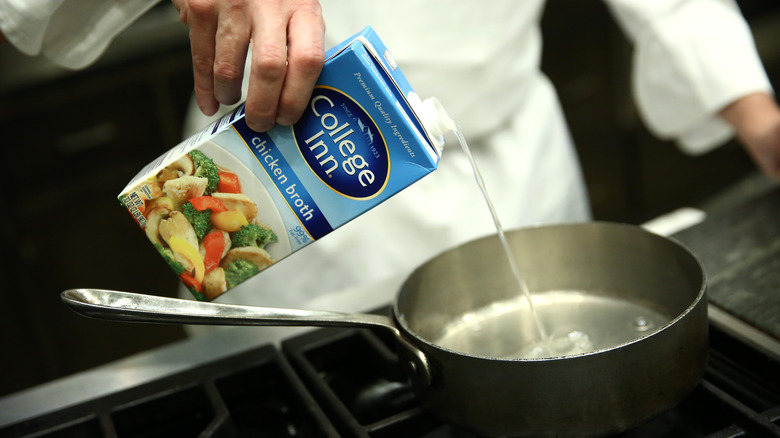Boxed Chicken Broth Is Tasty, But One Umami Paste Takes It Up A Notch
Boxed chicken broth is good enough, but you can effortlessly transform it into something way better with a one-ingredient addition. You need miso paste. It is salty, nutty, and full of savory depth that instantly elevates chicken broth — or, really, any kind of boxed stock or broth, for that matter.
Miso is made from soybeans fermented with salt and koji, which is a specific fungus that grows on grains. White rice is most commonly used to inoculate the koji in commercial applications, but barley, brown rice, and soybeans are also used. The flavor varies depending on the type of miso, but regardless, it is best to incorporate it at the end of the cooking process, because the flavor can degrade when boiled. The best way to add miso to broth is to ladle out some of the liquid into a separate bowl, scoop in the paste, and whisk it until fully incorporated before adding the mixture back to the whole pot. Otherwise, miso can sometimes stay clumpy.
It is important to keep in mind that miso does have quite a concentrated and salty flavor, so it pairs best with low-sodium or salt-free broths. However, certain brands that do have salt already included in the mix sometimes need a boost, too, so just start with a little bit of miso, taste, and work your way up from there. Simply finish a miso-enhanced broth with poached veggies and protein, or use it as a flavorful base for any of your favorite soup, stew, and braising recipes.
Use different types of miso for flavor variety
Consider what you are intending to use your chicken broth for, and pick a variety of miso accordingly. Are you making a simple chicken noodle soup recipe that needs a little oomph, or are you going with low-and-slow braised beef short ribs that deserve another layer of rich flavor? Either way, there is a miso for you.
Shiro (white) miso and aka (red) miso are the most widely available types of miso in the United States. White miso has a light, sweet, and mild flavor, while red miso is bolder and saltier, though there is much variation within these broad categories. The flavors are affected by the type of grain used to inoculate the koji, fermentation time (the longer, the more intense), and the ratio of koji to soybeans. Choose white miso for light and subtle broths — like in the case of classic chicken noodle, creamy wild rice, and split pea soups — and opt for red miso when you want a punchier flavor to go with red meats, black beans, and hearty vegetables.
In Japan, there are upwards of 1,000 different types of miso and countless familial and regional variations, but if you can't book a flight today, you should still find a decent variety at Asian markets. Try earthy genmai miso in a broth with mushrooms, or golden shinshu miso in a turmeric-and-ginger-spiked chicken broth. You can even use miso to hack traditional canned soups for extra flavor. Basic chicken broth will never be boring again.


